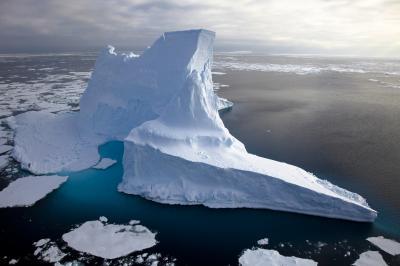Evidence for massive and abrupt iceberg calving in Antarctica dating back 19,000 to 9,000 years ago is based on an analysis of new, long deep sea sediment cores extracted from the region between the Falkland Islands and the Antarctic Peninsula.
The study in Nature documents that the Antarctic ice sheet is unstable and can abruptly reorganize Southern Hemisphere climate and cause rapid global sea level rise.
What brought about such huge ice-sheet collapses in Antarctica back then, since there was no Anthropocene to implicate? For that, the researchers had to fall back on climate modeling experiments.

The first evidence for massive and abrupt iceberg calving in Antarctica, dating back 19,000 to 9,000 years ago, has now been documented by an international team of geologists and climate scientists. Credit: Frank Roedel, Alfred Wegener Institute
"One of the iceberg events in our data that is of particular interest took place 14,600 years ago and coincided with a huge ice-sheet melt, the famous Meltwater Pulse 1A, which according to previous studies led to a global sea level rise of about 4 meters within 100 years," says lead author of the study, Michael Weber at the University of Cologne in Germany.
"This is the first direct evidence that instabilities of the Antarctic ice sheet caused rapid sea level rise during the last glacial termination," says co-author Peter Clark, professor at Oregon State University.
"An unusually strong flow of warm water towards Antarctica may have triggered these events. Our model experiments reveal further that the associated melting in turn increased the warm water flow, thus providing a positive feedback. This is a perfect recipe for rapid sea level rise," explains co-author Axel Timmermann, professor at the International Pacific Research Center of the University of Hawaii.
The new findings document that the Antarctic ice-sheet underwent rapid changes in an otherwise gradual transition from glacial to interglacial times in the Southern Hemisphere.
"Our paleo data of abrupt ice-sheet instabilities provide an important benchmark against which future projections of human-induced changes in Antarctic ice volume and global sea level can be evaluated," says Gerrit Lohmann, professor at the Alfred Wegener Institute, Bremerhaven, Germany.






Comments